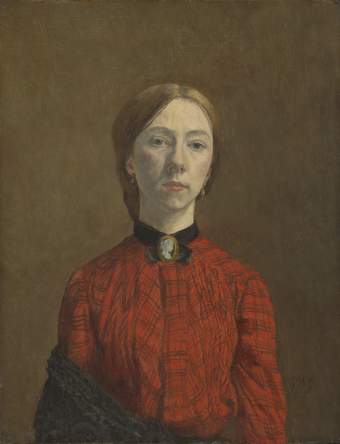This is Nameless and Friendless by Emily Mary Osborn.
Painted in 1857, it was intended as a political statement about women's rights.
In Nameless and Friendless, Osborn shows us the situation of a single vulnerable woman in Victorian England. Female artists were uncommon in Victorian times. Her black dress suggests that she is mourning someone and is likely to be supporting herself alone.
Outside it's raining and her mud-splattered skirt and dripping umbrella tell us she has travelled through terrible conditions to get here.
Accompanied by a boy, possibly her brother, she offers her paintings to an art dealer. Her downcast face and his curious expression suggest rejection. A young man on a ladder looks down on her painting, while across the room two older men stare at the artist. Isolated in the centre of the composition, the artist looks downwards and nervously pulls at the knotted string that once bound her picture.
When first shown at the Royal Academy in London, Osborn included a quote from the Bible in the title of the painting: 'The rich man's wealth is his strong City'. In Victorian England, the city and the outside world were considered the place of men, with women's roles restricted to indoor and domestic environments.
In Nameless and Friendless, Osborn presents us with common models of femininity that existed in Victorian society, but also offers an alternative.
In the corner, the men leering at the artist are holding a picture of a ballerina, a working female figure that was commonly objectified and sexualized by conservative Victorians.
Leaving the shop with her son is a middle-class woman, representing a domestic female figure: a wife and a mother who is secure as part of a family, but whose face is invisible.
Our protagonist, however, represents a third choice: a single woman trying to earn a living on her own, in a trade traditionally occupied by men. However, in this hostile environment, she becomes nameless and friendless.
Emily Mary Osborn was actively involved in the campaign for women's rights that gathered momentum in the mid-19th century. In 1859, Osborn signed a petition to the Royal Academy of Arts to open its schools to female students, which it did a year later in 1860. And in 1889, she campaigned for the Declaration in Favour of Women's Suffrage.
Osborn's own career was far removed from the woman in Nameless and Friendless. The daughter of a priest, she was encouraged to be an artist by her family and was supported by wealthy patrons, including Queen Victoria.
However, she used this position of power to help improve the lives of women like those depicted in her paintings.
Nameless and Friendless was painted in 1857 by Emily Mary Osborn. It captures a single woman trying, and failing, to earn a living as an artist in Victorian England. In a trade traditionally occupied by men, she becomes nameless and friendless.
Osborn was actively involved in the campaign for women’s rights during the mid-19th century. She was supported by wealthy patrons, including Queen Victoria. But she used her position of power to help improve the lives of women like those depicted in her paintings.



